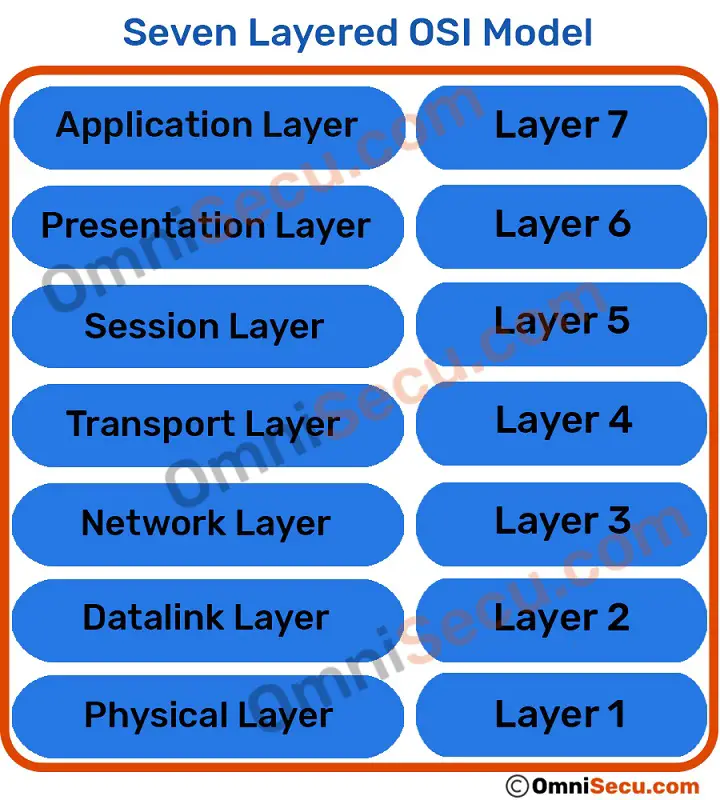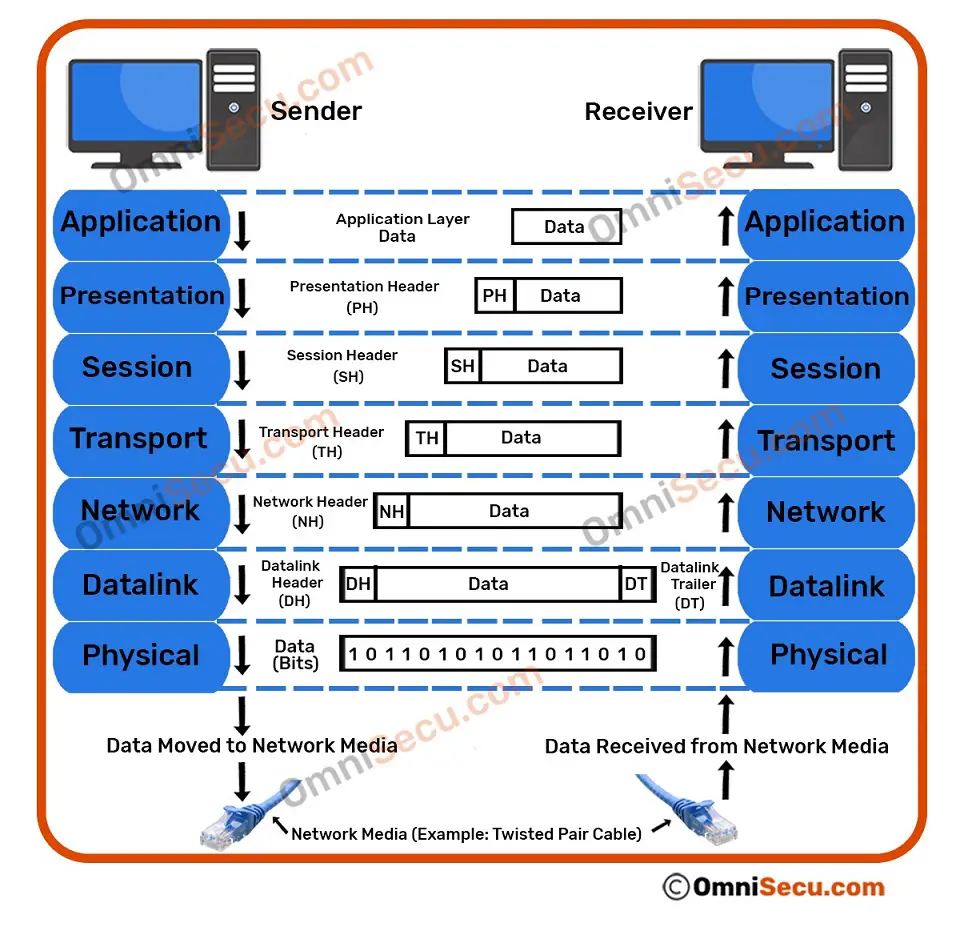Seven Layers of OSI Model and functions of seven layers of OSI model
In Seven Layers of Open Systems Interconnection (OSI) Model lesson, you will learn about the seven layers of OSI model and their functions.
If network communications need to happen without any trouble, many problems must be solved. Coordinating all these problems are so complex and not easy to manage. To make these tasks smooth, in 1977 the International Standards Organization (ISO) proposed the Open Systems Interconnection (OSI) network model. The Open Systems Interconnection (OSI) model breaks down the problems involved in moving data from one computer to another computer. Open Systems Interconnection (OSI) model categorizes these hundreds of problems to Seven Layers. A layer in Open Systems Interconnection (OSI) model is a portion that is used to categorize specific problems.
Open Systems Interconnection (OSI) is just a seven layered reference model. All the problems which are related to the communications are answered by specific protocols operating at different layers.
Following image shows the seven layers described in OSI (Open Systems Interconnection) model.

Layer 1. Physical Layer
The first layer of the seven layers of Open Systems Interconnection (OSI) network model is called the Physical layer. Physical circuits are created on the physical layer of Open Systems Interconnection (OSI) model. Physical layers describe the electrical or optical signals used for communication. Physical layer of the Open Systems Interconnection (OSI) model is only concerned with the physical characteristics of electrical or optical signaling techniques which includes the voltage of the electrical current used to transport the signal, the media type (Twisted Pair, Coaxial Cable, Optical Fiber etc.), impedance characteristics, physical shape of the connector, Synchronization etc. The Physical Layer is limited to the processes needed to place the communication signals over the media, and to receive signals coming from that media. The lower boundary of the physical layer of the Open Systems Interconnection (OSI) model is the physical connector attached to the transmission media. Physical layer of the Open Systems Interconnection (OSI) model does not include the transmission media. Transmission media stays outside the scope of the Physical Layer and are also referred to as Layer 0 of the Open Systems Interconnection (OSI) Model.
Layer 2. Datalink Layer
The second layer of the seven layers of Open Systems Interconnection (OSI) network model is called the Datalink layer. The Data Link layer resides above the Physical layer and below the Network layer. The Data Link Layer is logically divided into two sublayers, The Media Access Control (MAC) Sublayer and the Logical Link Control (LLC) Sublayer.
Media Access Control (MAC) Sublayer determines the physical addressing of the hosts. The MAC sub-layer maintains MAC addresses (physical device addresses) for communicating with other devices on the network. MAC addresses are burned into the network cards and constitute the low-level address used to determine the source and destination of network traffic. MAC Addresses are also known as Physical addresses, Layer 2 addresses, or Hardware addresses.
The Logical Link Control sublayer is responsible for synchronizing frames, error checking, and flow control.
Layer 3. Network Layer
The third layer of the seven layers of Open Systems Interconnection (OSI) network model is the Network layer. The Network layer of the OSI model is responsible for managing logical addressing information in the packets and the delivery of those packets to the correct destination. Routers, which are special computers used to build the network, direct the data packet generated by Network Layer using information stored in a table known as routing table. The routing table is a list of available destinations that are stored in memory on the routers. The network layer is responsible for working with logical addresses. The logical addresses are used to uniquely identify a computer on the network, but at the same time identify the network that system resides on. The logical address is used by network layer protocols to deliver the packets to the correct network. The Logical addressing system used in Network Layer is known as IP address.
IP addresses are also known as Logical addresses or Layer 3 addresses.
Layer 4. Transport Layer
The fourth layer of the seven layers of Open Systems Interconnection (OSI) network mode is the Transport layer. The Transport layer handles transport functions such as reliable or unreliable delivery of the data to the destination. On the sending computer, the transport layer is responsible for breaking the data into smaller packets, so that if any packet is lost during transmission, the missing packets can be sent again. Missing packets are determined by acknowledgments (ACKs) from the remote device, when the remote device receives the packets. At the receiving system, the transport layer will be responsible for opening all of the packets and reconstructing the original message.
Another function of the transport layer is TCP segment sequencing. Sequencing is a connection-oriented service that takes TCP segments that are received out of order and place them in the right order.
The transport layer also enables the option of specifying a "service address" for the services or application on the source and the destination computer to specify what application the request came from and what application the request is going to.
Many network applications can run on a computer simultaneously and there should be some mechanism to identify which application should receive the incoming data. To make this work correctly, incoming data from different applications are multiplexed at the Transport layer and sent to the bottom layers. On the other side of the communication, the data received from the bottom layers are de-multiplexed at the Transport layer and delivered to the correct application. This is achieved by using "Port Numbers".
The protocols operating at the Transport Layer, TCP (Transmission Control Protocol) and UDP (User Datagram Protocol) uses a mechanism known as "Port Number" to enable multiplexing and de-multiplexing. Port numbers identify the originating network application on the source computer and destination network application on the receiving computer.
Layer 5. Session Layer
The position of Session Layer of the Seven Layered Open Systems Interconnection (OSI) model is between Transport Layer and the Presentation Layer. Session layer is the fifth layer of seven layered Open Systems Interconnection (OSI) Model. The session layer is responsible for establishing, managing, and terminating connections between applications at each end of the communication.
In the connection establishment phase, the service and the rules (who transmits and when, how much data can be sent at a time etc.) for communication between the two devices are proposed. The participating devices must agree on the rules. Once the rules are established, the data transfer phase begins. Connection termination occurs when the session is complete, and communication ends gracefully.
In practice, Session Layer is often combined with the Transport Layer.
Layer 6. Presentation Layer
The position of Presentation Layer in seven layered Open Systems Interconnection (OSI) model is just below the Application Layer. When the presentation layer receives data from the application layer, to be sent over the network, it makes sure that the data is in the proper format. If it is not, the presentation layer converts the data to the proper format. On the other side of communication, when the presentation layer receives network data from the session layer, it makes sure that the data is in the proper format and once again converts it if it is not.
Formatting functions at the presentation layer may include compression, encryption, and ensuring that the character code set (ASCII, Unicode, EBCDIC (Extended Binary Coded Decimal Interchange Code, which is used in IBM servers) etc.) can be interpreted on the other side.
For example, if we select to compress the data from a network application that we are using, the Application Layer will pass that request to the Presentation Layer, but it will be the Presentation Layer that does the compression.
Layer 7. Application Layer
The Application Layer the seventh layer in OSI network model. Application Layer is the top-most layer of the seven layered Open Systems Interconnection (OSI) network model. Real traffic data will be often generated from the Application Layer. This may be a web request generated from HTTP protocol, a command from telnet protocol, a file download request from FTP protocol etc.
Following image shows the data flow in OSI model, when network communication happens between two computers.

In this lesson (Seven Layers of Open Systems Interconnection (OSI) Model), you have learned what are the Seven Layers of Open Systems Interconnection (OSI) Model and the functions of these seven layers. The top-most layer of the Seven Layers of Open Systems Interconnection (OSI) Model is the Application Layer and the bottom-most layer of the Seven Layers of Open Systems Interconnection (OSI) Model is Physical Layer. Click "Next" to Continue.